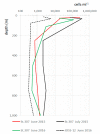The "Dark Side" of Picocyanobacteria: Life as We Do Not Know It (Yet)
- PMID: 35336120
- PMCID: PMC8955281
- DOI: 10.3390/microorganisms10030546
The "Dark Side" of Picocyanobacteria: Life as We Do Not Know It (Yet)
Abstract
Picocyanobacteria of the genus Synechococcus (together with Cyanobium and Prochlorococcus) have captured the attention of microbial ecologists since their description in the 1970s. These pico-sized microorganisms are ubiquitous in aquatic environments and are known to be some of the most ancient and adaptable primary producers. Yet, it was only recently, and thanks to developments in molecular biology and in the understanding of gene sequences and genomes, that we could shed light on the depth of the connection between their evolution and the history of life on the planet. Here, we briefly review the current understanding of these small prokaryotic cells, from their physiological features to their role and dynamics in different aquatic environments, focussing particularly on the still poorly understood ability of picocyanobacteria to adapt to dark conditions. While the recent discovery of Synechococcus strains able to survive in the deep Black Sea highlights how adaptable picocyanobacteria can be, it also raises more questions-showing how much we still do not know about microbial life. Using available information from brackish Black Sea strains able to perform and survive in dark (anoxic) conditions, we illustrate how adaptation to narrow ecological niches interacts with gene evolution and metabolic capacity.
Keywords: Black Sea; Synechococcus; mesopelagic zone; picocyanobacteria.
Conflict of interest statement
The authors declare no conflict of interest.
Figures







References
-
- Johnson P.W., Sieburth J.M.N. Chrococcoid cyanobacteria in the sea: A ubiquitous and diverse phototrophic biomass. Limnol. Oceanogr. 1979;24:928–935. doi: 10.4319/lo.1979.24.5.0928. - DOI
-
- Callieri C., Cronberg G., Stockner J.G. Freshwater picocyanobacteria- single cells, microcolonies and colonial forms. In: Whitton B., editor. Ecology of Cyanobacteria II: Their Diversity in Space and Time. 2nd ed. Springer; Dordrecht, The Netherlands: 2012. pp. 229–269.
-
- Scanlan D.J. Marine Picocyanobacteria. In: Whitton B., editor. Ecology of Cyanobacteria II: Their Diversity in Space and Time. 2nd ed. Springer; Dordrecht, The Netherlands: 2012. pp. 503–533.
-
- Waterbury J.B., Watson S.W., Guillard R.R.L., Brand L.E.E. Widespread occurrence of a unicellular, marine, planktonic cyanobacterium. Nature. 1979;227:293–294. doi: 10.1038/277293a0. - DOI
Publication types
LinkOut - more resources
Full Text Sources

